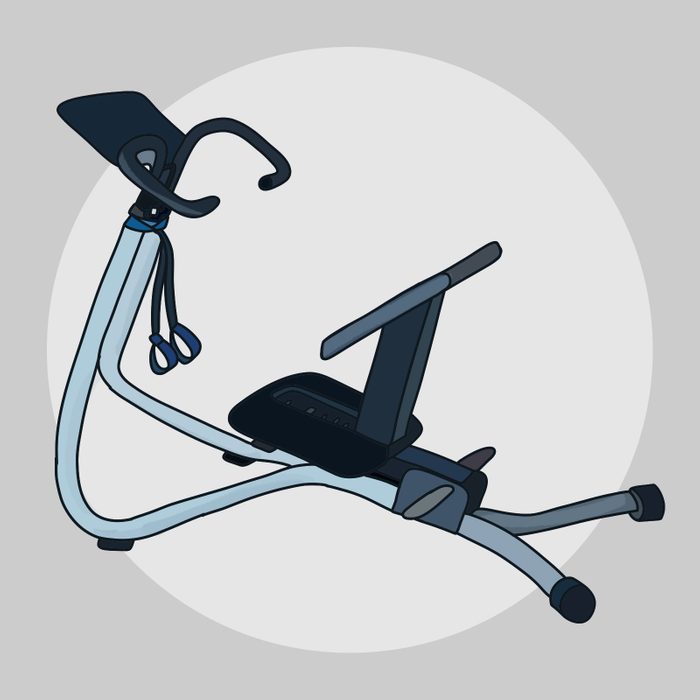Here’s What Experts Think About Stretching Machines

Before you buy a stretching machine, make sure it's really worth the cost.
On the surface, stretching machines seem like a good idea—if they’re designed to help improve flexibility, and flexibility is an important part of fitness, then certainly they’re worth using, right? Plus, machines are often included with strength training and cardiovascular workouts, so by the same logic, stretching machines could supplement or enhance a flexibility workout, too. Granted, the logic isn’t wrong, but it’s not necessarily right, either. Certainly, when used correctly, stretching machines can help enhance flexibility.
But what you need to ask yourself is whether improved flexibility is really the best goal, and even if it is, are these machines worth the cost? Generally, the answer is no. Here’s what experts want you to know about stretching machines.
(Related: 4 Stretches to Improve Range of Motion as You Age)
There’s a difference between flexibility and range of motion
“People often confuse flexibility and mobility,” says Alex Tauberg, DC, CSCS, the owner of Tauberg Chiropractic and Rehabilitation in Pittsburgh. “Flexibility is the ability to elongate a muscle. Mobility is the ability to move a joint through its range of motion.”
In general, it’s better to focus on improving active mobility rather than flexibility, according to Tauberg. “This ends up improving your flexibility as well, but has the benefit of being tied in more closely with everyday activities,” he says.
To give you a clear picture of the difference, mobility has to do with moving well throughout the day to perform the activities you need and want to perform. Flexibility has to do with how far a particular muscle can move at a particular joint. You can have poor flexibility or excessive flexibility, and flexibility can be affected by genetics and training.
While flexibility can play a role in mobility, it’s possible for a person to be perfectly mobile for their given needs without being overly flexible. For instance, a person may be able to walk around, squat down, and chase after a toddler without being able to do splits or bend over and touch the floor. Their mobility allows them to live a perfectly satisfying life without having a need for greater flexibility. And while you can certainly use a stretching machine to increase flexibility, this type of stretching may not have a direct correlation with improved mobility.
As such, unless a professional has indicated that you need to work on muscle-specific flexibility with static stretching, you’re likely better off pursuing other types of mobility training. And even if you do need to work on flexibility, using a stretching machine may not be the best option.
(Related: 3 Essential Support and Mobility Moves for Your Back)
Stretching machines are an expensive way to increase flexibility
“Stretching machines allow you to go deeper into a stretch then you otherwise would be able to. Theoretically they could help improve flexibility more than just normal static stretching,” Tauberg says. “That said, there are various stretching techniques you can do without a stretching machine that can also accomplish these goals. One example would be post-isometric relaxation stretching.”
This type of stretching involves a static stretch, followed by an isometric contraction, followed by muscle relaxation and continued light stretching.
Often, people perform this type of stretch with a partner in a therapeutic setting (chiropractors and therapists are trained how to do it correctly), but it would be possible to do similar stretches at home using a stretch strap in place of a partner. And a $10 stretch strap is a whole lot more affordable (and less bulky) than a several hundred dollar stretching machine. For example, to increase flexibility of your hamstrings, you could perform a version of a post-isometric relaxation stretch with a stretch strap.
(Related: The Benefits of Having an At-Home Pilates Machine)
When the goal is better mobility, there are better options
Unless you’re working with a trainer, chiropractor, or physical therapist to pursue specific flexibility-related goals, there’s really no sense in buying or using a stretching machine. “For my money, I’d skip the stretching machine and focus more on mobility,” Tauberg says. And if you’re not sure how to go about doing that, pretty much any activity that takes your muscles through a full range of motion will do the trick.
Tauberg points to yoga and tai chi as practical and readily accessible options (just hit up YouTube for free tutorials). But there are other options, too. For instance, you could start including a dynamic stretching routine before your workouts. A technique known as eccentric training can be effective, too, according to a 2012 review study published in the British Journal of Sports Medicine, which found eccentric training can improve lower limb flexibility.
Just make sure you focus on functional movements like squats, lunges, push-ups, and pull-ups performed with perfect form. These exercises, when done correctly, can help increase mobility and flexibility at your major joints.
Next, How Tai Chi Can Help Build Muscle Strength and Flexibility




